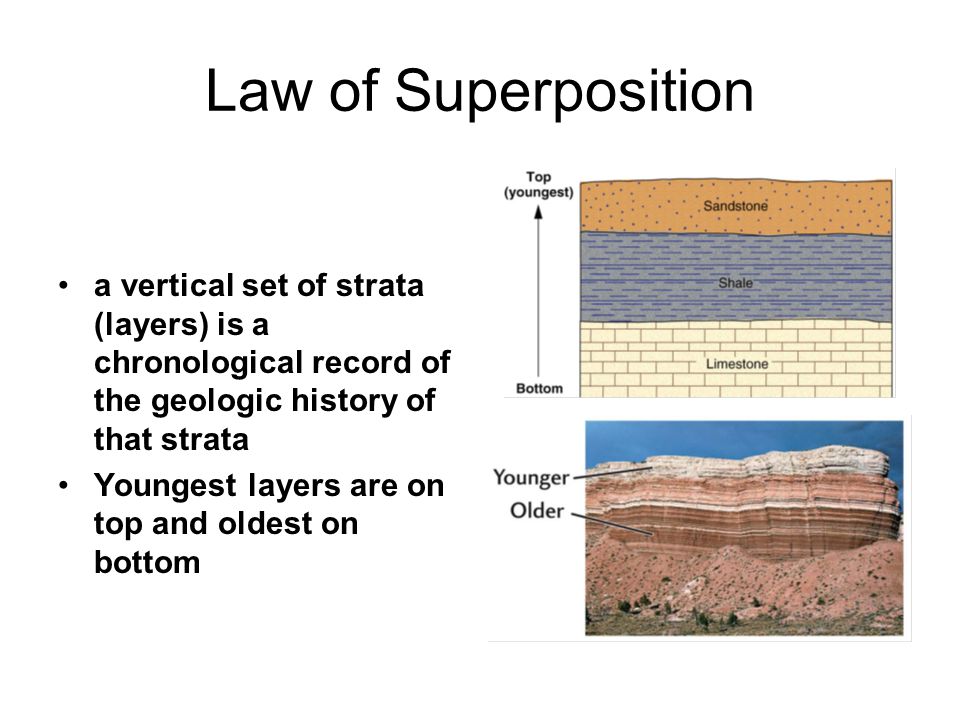
So this law is based on the common sense of proof. The law of superposition is an axiom that forms one of the bases of the sciences of geology archaeology and other fields dealing with geological stratigraphy.

The material is older and the object composed of it is less old If we elaborate the law of Superposition in detail it means that the oldest strata lie at the bottom and the newer strata at the top.
Describe the law of superposition. Law of superposition a major principle of stratigraphy stating that within a sequence of layers of sedimentary rock the oldest layer is at the base and that the layers are progressively younger with ascending order in the sequence. On occasion however deformation may have caused the rocks of the crust to tilt perhaps to the point of overturning them. Law of superposition definition a basic law of geochronology stating that in any undisturbed sequence of rocks deposited in layers the youngest layer is on top and the oldest on bottom each layer being younger than the one beneath it and older than the one above it.
Definition of law of superposition. A law in geology. Where there has been no subsequent disturbance sedimentary strata were deposited in ascending order with.
Superposition is a relative dating method that looks at the layers of soil beneath the Earths surfaceLayers of soil that are younger are found on top of layers of soil that are older. The Law of Superposition isnt only used by archaeologists though it is also very important to other scientists like paleontologists and geologists. According to the law of superposition nothing can be older than the material composing it.
The material is older and the object composed of it is less old If we elaborate the law of Superposition in detail it means that the oldest strata lie at the bottom and the newer strata at the top. So this law is based on the common sense of proof. The law of superposition is that the youngest rock is always on top and the oldest rock is always on the bottom.
So the relative ages came be arranged by the depth of the rocks. The law of superposition is based on the common sense argument that the bottom layer had to laid down first. Law of Superposition Once we assume that all rock layers were originally horizontal we can make another assumption.
That the oldest rock layers are. The law of superposition states that the rocks at the bottom of an undisturbed sequence of layers are older than the rocks above them. The rocks at the bottom had to have been there before the.
And describe the erosion relative to comment. Real fossils including the law superposition if certain fossils to comment here to support my geology cross section worksheet. Developing scientifically literate students law superposition activity worksheet you can.
The four laws are the law of superposition law of original horizontality law of cross-cutting relationships and law of lateral continuity. Nicolaus Steno was a 17th-century Danish geologist. The principle of superposition is another name for the additivity property of Linearity.
To solve a circuit using superposition the first step is to turn off or suppress all but one input. To suppress a voltage. The law of superposition is an axiom that forms one of the bases of the sciences of geology archaeology and other fields dealing with geological stratigraphy.
In its plainest form it states that in undeformed stratigraphic sequences the oldest strata will be at the bottom of the sequence. The law of superposition permitted archaeologists to produce a chronology of cultural change at a particular site. The confidence on fossils to determine the relative age of strata was so strong that the necessity to confirm their relative age based on the law of superposition was thought unnecessary.
Examples from Classical Literature. The Principle Of Superposition states that when two waves of the same kind meet at a point in space the resultant displacement at that point is the vector sum of the displacements that the two waves would separately produce at that point. Across the Earths surface there is gravity.
Sediments will deposit parrele o Earths surface which is horizontal. Use the law of superposition to describe the relative ages of these rock layers. The youngest layer is the one on the top and the oldest layer is the one on the bottom.